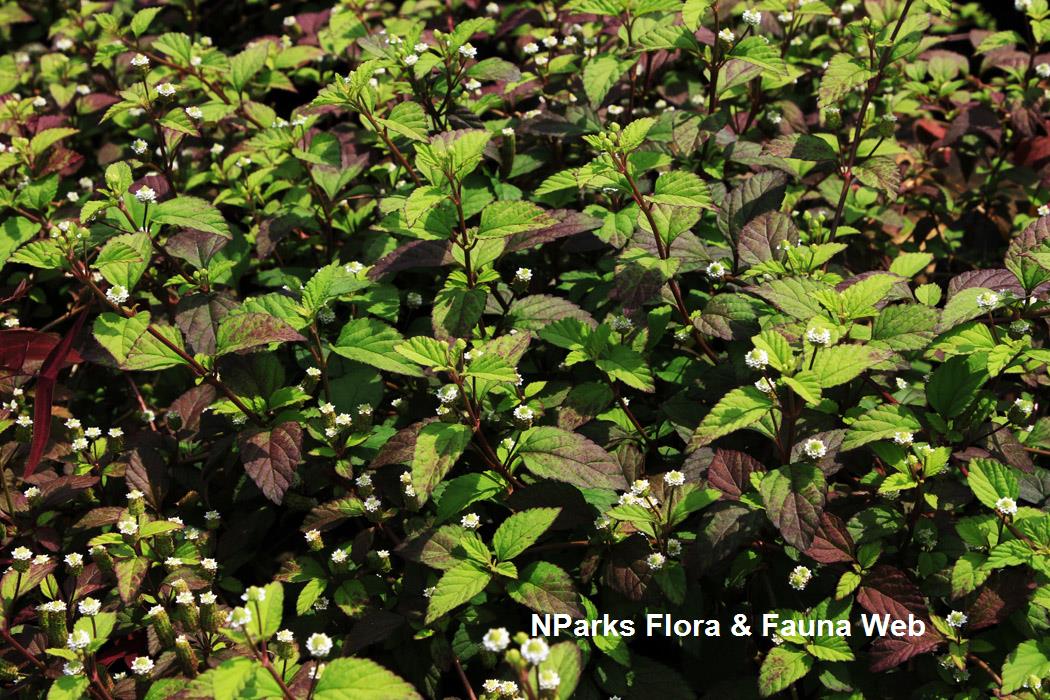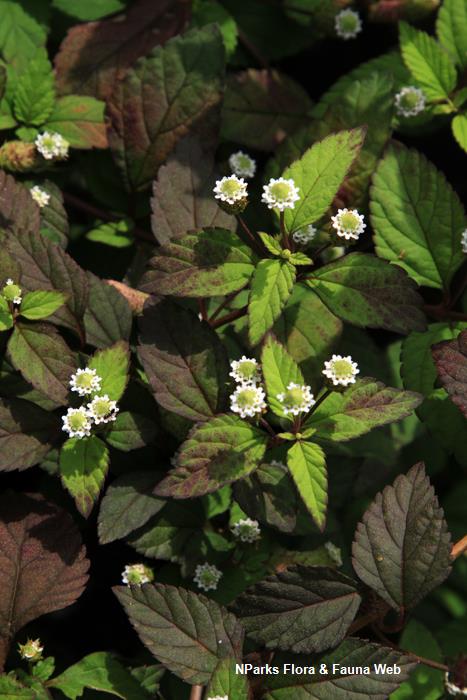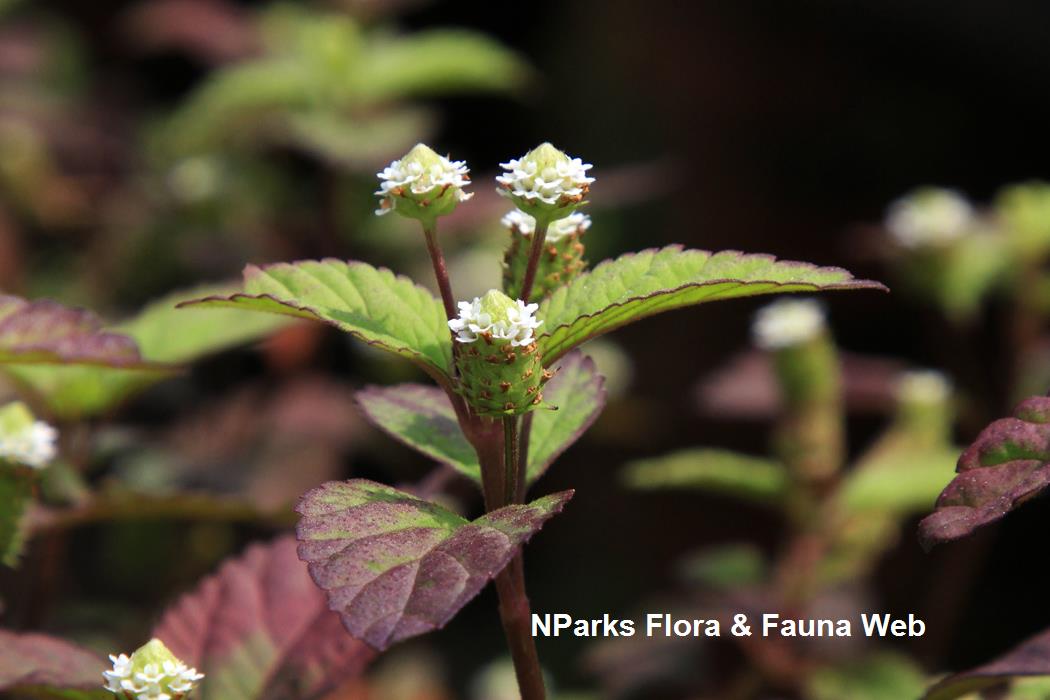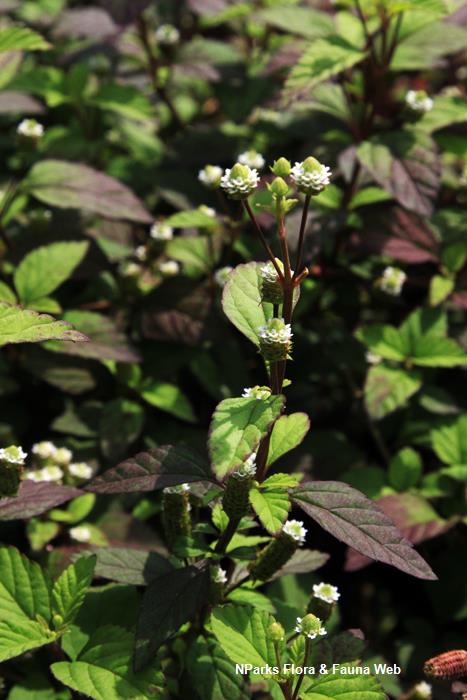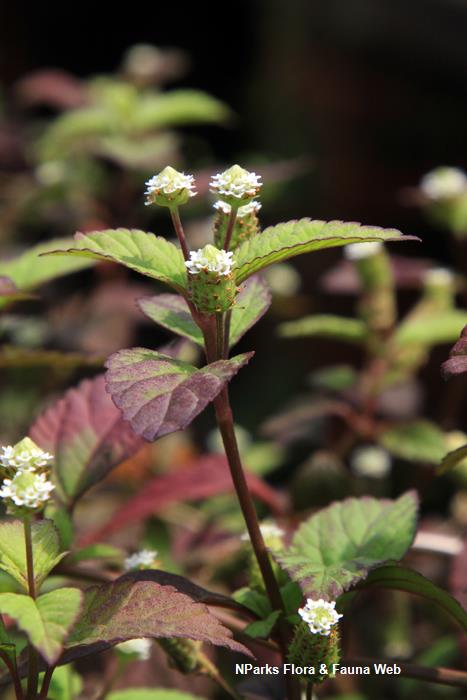
Back
Lippia dulcis Trevir.
| Family Name: | Verbenaceae |
| Synonyms: | Phyla dulcis (Trevir.) Moldenke, Lippia asperifolia Rchb., Lippia dulcis var. mexicana Wehmer, Phyla scaberrima (Juss. ex Pers.) Moldenke, Zappania scaberrima Juss. ex Pers. |
| Common Name: | Aztec Sweet Herb, Aztec Sweet Box, Mexican Lippia, Bushy Lippia, Honeyherb, Yerba Dulce |
Aztec Sweet Herb are sprawling creepers that can reach 30 cm tall. Free flowering in full sun, the cone-shaped inflorescences bear tiny white flowers around the circumference of the cone. Leaves have a sweet taste and were traditionally used by the Aztecs as an herbal sweetener.
Name
Classifications and Characteristics
| Plant Division | Angiosperms (Flowering Seed Plants) (Dicotyledon) |
|---|---|
| Plant Growth Form | Herbaceous Plant, Creeper |
| Lifespan (in Singapore) | Perennial |
| Mode of Nutrition | Autotrophic |
| Maximum Height | 0.3 m |
| Maximum Plant Spread / Crown Width | 1 m |
Biogeography
| Native Distribution | Mexico to Venezuela, Caribbean |
|---|---|
| Native Habitat | Terrestrial |
| Local Conservation Status | Non-native |
Description and Ethnobotany
| Growth Form | Herb up to 0.3 m tall with creeping or mat-forming growth habit. |
|---|---|
| Foliage | Egg-shaped, deeply veined leaves with toothed leaf margin are arranged in pairs. |
| Flowers | Tiny, white flowers are arranged in a circle at the top of a round to oblong inflorescence. |
| Associated Fauna | Flowers are insect-pollinated. |
| Cultivation | Leaves may turn brown-purple under full sun. It grows best in well-drained soil that is allowed to mostly dry before re-watering. |
| Etymology | Lippia was named for Augustin Lippi, Italian naturalist. Dulcis is Latin for sweet with reference to the sweet tasting leaves. The species is commonly known as Sweet Aztec Herb, because the Aztecs used the plant as a sweetener. |
| Ethnobotanical Uses | Medicinal: In Mexico, the plant was traditionally used to treat cough and bronchitis in the late 1800s and thought to induce abortion in the late 1900s. <2> Leaves taste sweet because they contain a hernandulcin, a non-toxic compound said to be a thousand times sweeter than sucrose (also known as table sugar). <1> However, they also contain toxic camphor which can be more than half the volatile oil content. <2> It is best not to eat them in large quantities. |
Landscaping Features
| Desirable Plant Features | Fragrant (Foliage) |
|---|---|
| Landscape Uses | Groundcover, Suitable for Hanging Baskets, Container Planting |
| Usage Hazard - Cons Remarks | Leaves should not be eaten in large quantities, as their essential oil might be rich in camphor which can be harmful. <1> |
Plant Care and Propagation
| Light Preference | Full Sun, Semi-Shade |
|---|---|
| Water Preference | Moderate Water |
| Plant Growth Rate | Fast to Moderate |
| Rootzone Tolerance | Drought Tolerant |
Foliar
| Mature Foliage Colour(s) | Green |
|---|---|
| Mature Foliage Texture(s) | Raised / Sunken Veins |
| Foliar Type | Simple / Unifoliate |
| Foliar Arrangement Along Stem | Opposite |
| Foliar Attachment to Stem | Petiolate |
| Foliar Shape(s) | |
| Foliar Venation | Pinnate / Net |
| Foliar Margin | Serrate / Toothed |
| Foliar Apex - Tip | Acute |
| Foliar Base | Rounded / Obtuse |
| Typical Foliar Area | Microphyll ( 2.25cm2 - 20.25 cm2 ) |
| Typical Foliar Size | 1 cm to 4 cm |
Floral (Angiosperm)
| Flower Colour(s) | White |
|---|---|
| Flower Texture(s) | Smooth |
| Flower Grouping | Cluster / Inflorescence |
| Flower Location | Terminal |
| Flower Symmetry | Bilateral |
References
| References | <1> Compadre, C.M., Pezzuto, J.M., Kinghorn, A.D., Kamath, S.K. (1985). Hernandulcin: An intensely sweet compound discovered by review of ancient literature. Science 227(4685): 417–419. <2> Compadre, C.M., Robbins, E.F. & Kinghorn, A.D. (1986). The intensely sweet herb, Lippia dulcis Trev.: Historical uses, field inquiries, and constituents. J of Ethnopharmacology 15: 89–106.
|
|---|
Image Repository
Others
| Master ID | 34280 |
|---|---|
| Species ID | 8693 |
| Flora Disclaimer | The information in this website has been compiled from reliable sources, such as reference works on medicinal plants. It is not a substitute for medical advice or treatment and NParks does not purport to provide any medical advice. Readers should always consult his/her physician before using or consuming a plant for medicinal purposes. |

